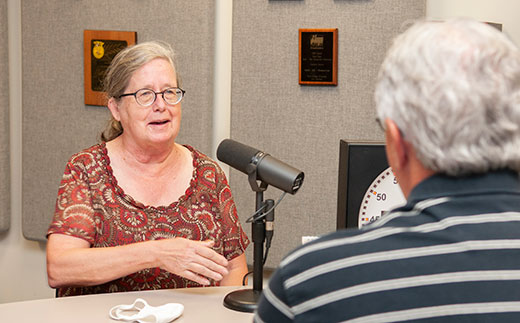
Mary Knapp will retire in September after more than 40 years as a climatologist at Kansas State University. | Download this photo.
Sun sets on Knapp’s weather career
Long-time climatologist helped build state’s robust weather network
Aug. 30, 2021
MANHATTAN, Kan. – One might guess that through the numerous storm warnings, tornados, floods, snow storms and more that Mary Knapp has experienced in more than 40 years as a climatologist in Kansas, one of those severe weather events would stand out.
They don’t. In fact, says Knapp, those weather events are right on par with any nice fall day when the sun is shining. “You know, one of those days when you’re saying, ‘hey, this is perfect weather,’” she said.
Knapp will retire in September after working at Kansas State University since 1980, having witnessed a dramatic makeover in how weather data is collected and used.
“I pretty much always have been interested in the weather and the climate,” Knapp said. “And I was very interested in agriculture.”
Listen to an interview by Jeff Wichman with Mary Knapp on the weekly radio program, Sound Living
Weather data is critical in states such as Kansas, where farmers and ranchers rely on good information to inform their business decisions.
“It’s also extremely vital when we’re looking at climate change, because one of the necessary parts of that is knowing what the conditions were before, and how have they changed,” Knapp said. “Knowing it on a station basis rather than on a global model basis is important so you can look at what is different about the climate in our particular area versus the global climate.”
As a newly-minted college graduate (she studied agronomy), Knapp spent a couple years in the Peace Corps before taking a job at K-State in 1980 growing crops for entomology research on corn borers.
“They were studying weather components, such as looking at how quickly the insects would develop and what (weather) factors were detrimental to their development,” Knapp said. The early work led to entomologists integrating weather data into the growth models for the Southwest Corn Borer and European corn borer, she said.
She succeeded Dean Bark as Kansas’ state climatologist in 1991, taking over K-State’s Weather Data Library, which was responsible for collecting and storing weather data. In 2013, Knapp was appointed as a service climatologist; Xiaomao Lin became the state climatologist and Chip Redmond served as network manager for the statewide Kansas Mesonet.
One of Knapp’s early projects with Bark was preserving Centennial Station data.
“Centennial Stations are those that have at least 100 years of weather data,” Knapp said. “What we were doing was typing in data that was available only on paper and making it available electronically.”
Manhattan’s history in weather observation dates to the mid-1850s, according to Knapp. The weather stations north of the K-State campus are some of the earliest that are part of the nation’s oldest weather network, the National Weather Service’s Co-op Observer network.
“It’s interesting to go back and look at some of the notes that people wrote in the late 1800s or early 1900s, where they would comment about being able to see an aurora in Manhattan, or look at the time that lightning struck the bell tower at Anderson Hall (on the K-State campus),” Knapp said.
In early days, Knapp said it often was individual professors that were taking weather observations, though it eventually became the responsibility of the Weather Data Library.
“Those weather records started out by using liquid in glass thermometers and a standard rain gauge,” she said. “That continued until very recently; in fact, Manhattan was one of the very last stations to switch to the electronic thermometer, which is known as the MMTS.”
The problem with the MMTS, she added, was that they run on electricity so had to be located very close to a power source, which may not be the best siting for weather observations.
“We pioneered using a solar panel to charge them,” Knapp said. “We have a weather station north of Call Hall, but it’s too far to run an electrical line to it. So, with plenty of open sky, we have a solar panel running that MMTS system.”
Today’s weather data is gathered through more sophisticated means, including networked computers and automated weather stations that send data back to a central location.
“But we still have volunteers that go out at 7 a.m. every day, make weather observations, record it and submit it to the National Weather Service where it goes into archives,” Knapp said.
One such system is the Community Collaborative Rain, Hail and Snow Network – better known as CoCoRaHS, a cadre of more than 800 Kansas volunteers who use a standard rain gauge to help measure precipitation across the state.
Kansas climate and weather information is available primarily on two websites, Knapp said. The Kansas Mesonet is a network of 75 weather stations that provide weather information that is updated every five minutes, as well as providing hourly and daily data.
The Weather Data Library also publishes a site, called Kansas Climate, that preserves long-term records of weather in Kansas. Knapp said the site lists information on temperature, precipitation and more dating to 1895.

